Carnations (scientifically known as Dianthus caryophyllus) are herbaceous perennials widely recognized for their striking flowers. They are used in gardens, landscape designs, and primarily as cut flowers for different types of floral arrangements.
Though considered the official Mother’s Day flower, carnations are also a popular flower gift for many occasions like birthdays, anniversaries, and more.
Read on to know about the different types of carnation flowers and some growing and caring tips.
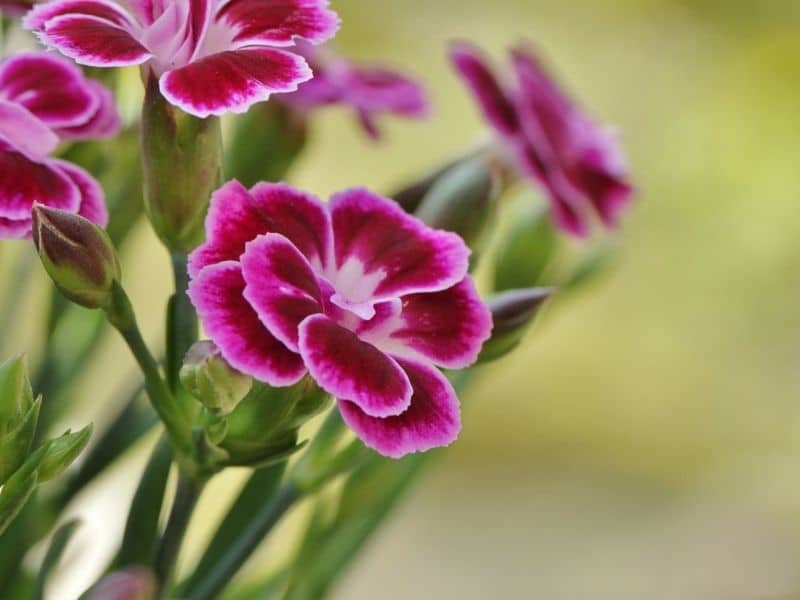
Facts about Dianthus caryophyllus
Carnation (Dianthus caryophyllus) is a flowering plant from the Pink or Carnation (Caryophyllaceae) botanical family. These plants have been in cultivation for over 2,000 years, recognized continuously worldwide for their fragrance and ruffle-like flowers.
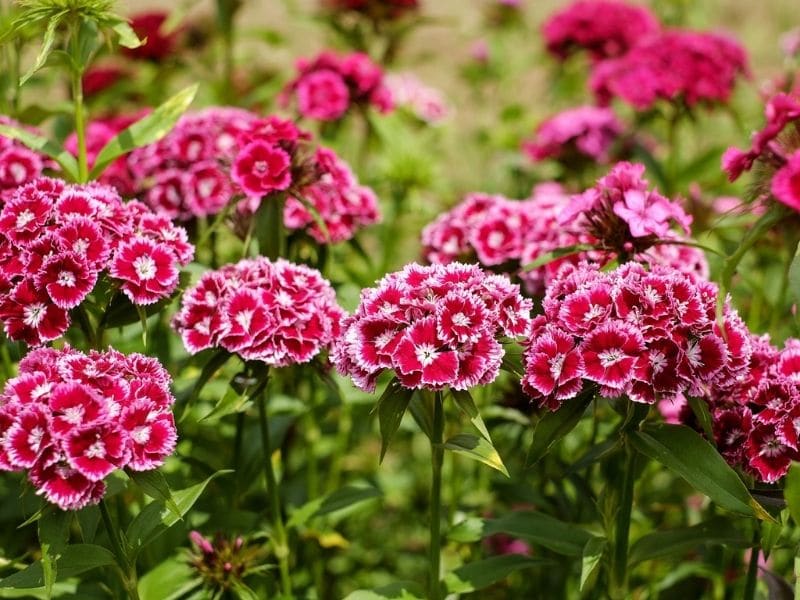
Carnations are also called clove pinks and grenadines. Is carnation an annual or perennial? Though they are herbaceous perennials, carnations can also be grown as annuals.
Carnation flowers come in a range of colors, ranging from red to white, pink, and bicolored varieties. White carnations are often dyed to create synthetic-colored blooms like black, green, and blue (1).
Taller varieties, which can grow up to 3 or 4 ft in height, are more commonly used as cut flowers and boutonnieres. (2).
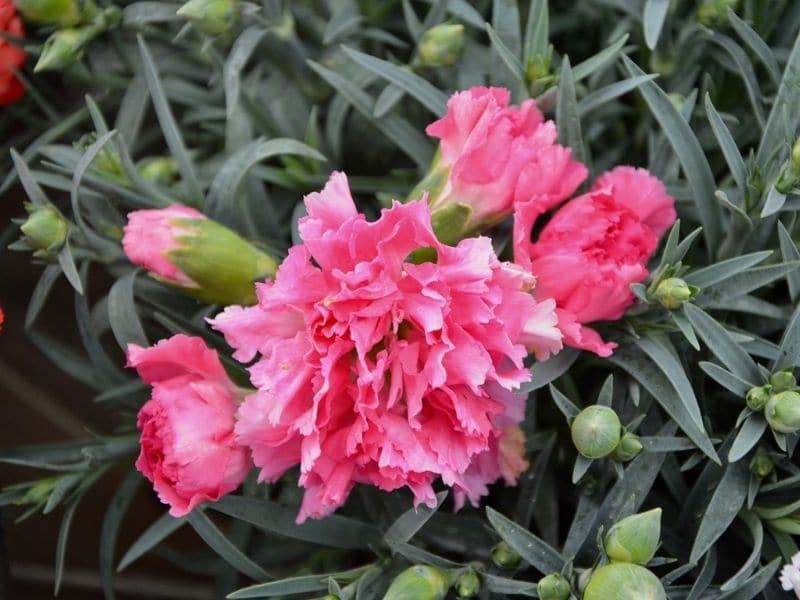
Carnation leaves are narrow, grey-blue, and stalkless. Although the branches are herbaceous, carnation stems are woody at the base (3).
Common Types of Carnation Flowers
Carnations have more or less 300 known species in varying colors, plant forms, flower sizes, and flower types. Since the genus is extensive, these plants can be classified depending on their flower types. Three popular types are large-flowered (standards or sims), dwarf flowered carnations (midis), or sprays (mini or miniatures) (3).
Large-Flowered Carnations
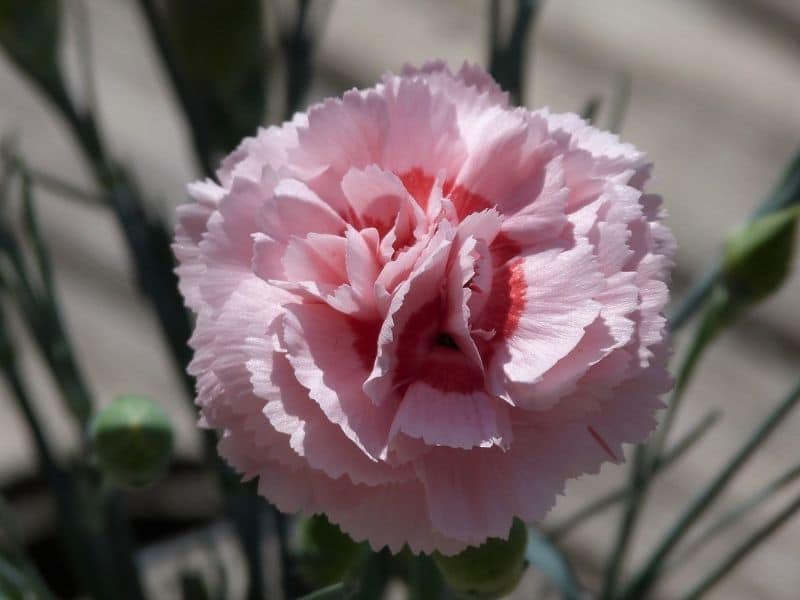
Large-flowered carnations, otherwise known as standard carnations, are those with a large, single flower per stem (3). They are the type of carnations commonly used as cut flowers. Their stems usually grow up to 18 to 24 inches in height.
Spray or Miniature Carnations
Spray carnations, otherwise called minis or miniature carnations, are those with five to six small flowers per stem (3).
They typically grow about 9 to 12 inches in height. ‘Elegance’ (white flowers with rose-pink edges), ‘Rony’ (scarlet flowers), ‘Tibet’ (white flowers), and ‘Exquisite’ (white flowers with violet edges) are some of the most popular cultivars of this carnation flower type (1).
Dwarf Carnations

Dwarf carnations are sometimes referred to as midis. They have smaller flowers and shorter stems than standard carnations. They grow up to about 9 to 12 inches tall. This type of carnation can produce one flower from a single stem or multiple blooms from its side branches (3).
Popular Carnation Cultivars
- Laced Romeo. It is a low-growing type that features double, fringed red flowers with hints of white. This variety of carnation grows up to 18 inches in height.
- Gina Porto. This variety produces salmon-colored carnations and grows up to 12 inches tall.
- Grenadin Kings of Black. This popular variety produces black-like carnations in a deep purple-red hue.
- Kahori. It is a hybrid Dianthus with long-blooming and fragrant rosy pink flowers. It grows upright and reaches up to 12 inches in height.
- Superstar. It produces cherry red carnation flowers with fringed petals and a darker center. It grows up to 8 inches tall.
How To Grow Carnations
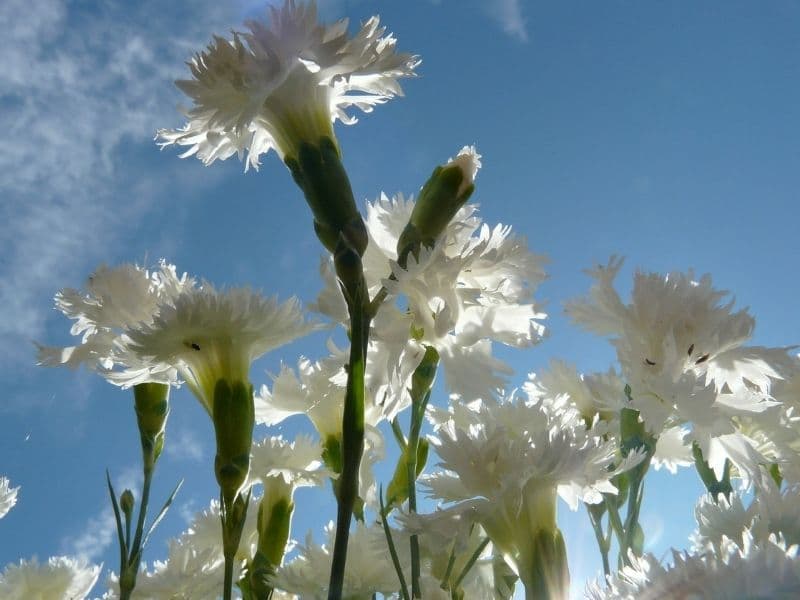
Light
Though carnations can tolerate partial shade, they need full sun or at least 4 to 6 hours of sunlight a day for optimum performance.
Light plays an essential factor in the growth of carnation flowers since it helps promote stem leafing and flower production. Insufficient, low, or filtered light may result in sparse branching, while overexposure to intense sun may damage the fragrant flowers.
Soil
If you are planting carnations, ensure that the soil is well-draining and slightly alkaline or more neutral in alkalinity. They do not grow well in acidic and soggy or clay soil types. Adding compost, manure, bark, or peat moss helps improve the soil drainage.
Water
As with most plants, carnations do not appreciate excessive moisture in the soil. Light watering two to three times per week is ideal, especially during the early stages of growth.
When watering, feel the soil make sure that it’s dry between watering schedules. Look out for yellowing leaves or flowers dropping as this often indicates overwatering. If you are growing potted carnations, ensure that the soil has good drainage and that the pot is large enough to accommodate the plant’s growth.
Temperature and Humidity carnations
The ideal temperatures for growing carnation flowers are between 50 and 65 degrees F in the day and 50 to 50 degrees F at night. For most carnation species, day temperatures over 70 degrees F can reduce flowering. Temperatures below 35 degrees F, on the other hand, can damage the carnation flowers.
However, some species like the Dianthus barbatus, D. gratianopolitanus, and D. chinensis can tolerate much lower temperatures.
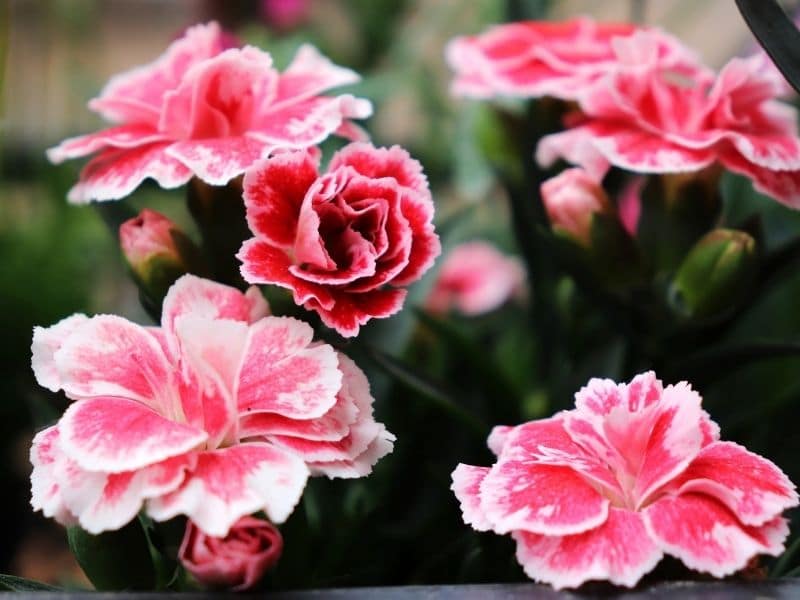
Fertilizer
Carnations will benefit from fertilization, but avoid using nitrogen-rich fertilizers since this will promote leaf production and not flowering. Feed your carnation plants with a balanced, slow-release fertilizer in spring every two weeks. Water the plants thoroughly after feeding.
Deadheading and Pruning
Deadheading is a common practice that helps encourage the carnation plant to produce more blooms. Though it can be unnecessary, removing or pinching off spent flowers will promote repeat flowering in some carnation flowers.
How to Plant Carnations

Growing Carnations from Seeds
Sow carnation seeds in a well-draining soil mix at about 1/8 inch deep with at least 12 inches spacing between seeds. The carnation seeds will germinate after two to three weeks. Do this in late fall to early spring.
Growing Carnations from Cuttings
Growing carnations from cuttings is a more common practice. The cuttings, obtained from terminal flowers, should measure about 4 to 6 inches in length. These are planted into pure sand for about 25 days until they are ready for transplanting.
Growing Carnations from Division
Carnations can also be grown by digging up the plant, dividing the plant segments, and replanting each division. The division of plants is usually done during late fall and every two to three years.
Carnation Pests and Diseases
Thrips
Thrips are one of the most serious insect pests of carnation flowers (3).
Both the nymphs and adult thrips cause damages to the plant by sucking the sap from the flowers and leaves. Symptoms of this tiny, needle-like insect infestation include brown or black droplets on the leaves and white, silvery markings on the petals and foliage (3).
Aphids
Aphids are small insects that feed on a carnation’s flower buds and undersides of leaves by sucking the sap. Symptoms of aphids attack include distorted young leaves and chlorotic spots on older leaves. Both the nymphs and adults are damaging to the plants.
Red Spider Mites
Red spider mites are tiny, spider-like insects that produce silk webbing. Like aphids and thrips, they feed on the plant by sucking the sap from carnation leaves. Symptoms of spider mites include visible small yellow or white speckles on the leaves.
Damaged leaves will then turn brown and drop prematurely. When the plants are heavily infested, they may appear discolored and stunted. These insects thrive and reproduce quickly in dry conditions.
Helicoverpa Caterpillars
Helicoverpa caterpillars are bud borers that affect carnation plants through boring holes on the flower buds and leaves. Infected plants often fail to produce carnation flowers since their buds won’t open.
Powdery Mildew
A fungal disease that affects many flowering plants, including carnations, powdery mildew thrives when the weather conditions are humid. Symptoms of powdery mildew include whitish or greyish powder on the surface of the leaves and curling.
Avoid overhead watering and provide sufficient airflow to prevent the occurrence of this disease.
Other Pests and Diseases of Carnation Plants
- Ants
- Earwigs
- Wireworms
- Slugs
- Bacterial Wilt
- Crown Gall
- Fasciation
- Rust
- Downy Mildew
- Carnation Etched Ring Virus (CERV)
FAQs
How can I make my carnations last longer?
To make your carnations last longer, ensure you start with a clean vase and fresh water, trim the stems at an angle, remove any leaves below the waterline, and change the water regularly.
Are carnations easy to keep alive?
Carnations are generally considered easy to keep alive, especially if you provide them with fresh water, keep them in a cool environment, and trim the stems regularly.
How long will carnations last?
With proper care, carnations can last anywhere from 7 to 14 days, depending on factors such as the quality of the flowers, the environment, and the care they receive.
Up Next: Carnation Flower Meaning and Symbolism
References
Reference List:
(1) Consider Carnations (2020). Available at: https://pss.uvm.edu/ppp/articles/carn.htm
(2) Dianthus caryophyllus (Border Carnation, Carnation, Clove Gilly-flower, Clove Pink, Gillyflower, Pinks, Sweet William, Wild Carnation) | North Carolina Extension Gardener Plant Toolbox (2020). Available at: https://plants.ces.ncsu.edu/plants/dianthus-caryophyllus/
(3) (2020) Ogtr.gov.au. Available at: http://www.ogtr.gov.au/internet/ogtr/publishing.nsf/content/carnation-3/$FILE/biologycarnation.pdf
(4) Horticulture :: Flower Crops :: Carnation (2020)
Close
Featured Image by evamorris/depositphotos







